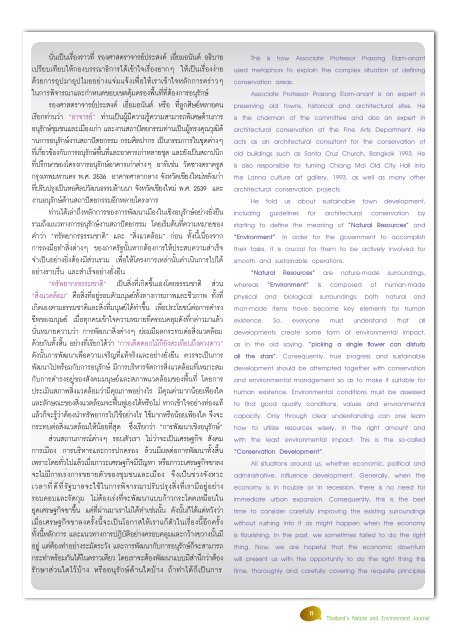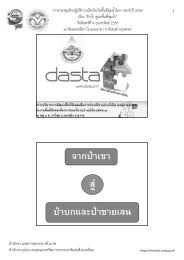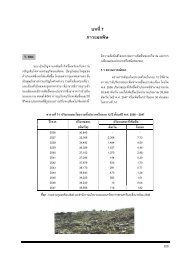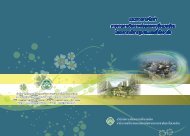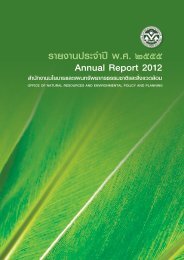ปีที่ 5 ฉบับที่ 3 กรกฎาคม-กันยายน 2552 - สำนักงานนโยบายและแผน ...
ปีที่ 5 ฉบับที่ 3 กรกฎาคม-กันยายน 2552 - สำนักงานนโยบายและแผน ...
ปีที่ 5 ฉบับที่ 3 กรกฎาคม-กันยายน 2552 - สำนักงานนโยบายและแผน ...
Create successful ePaper yourself
Turn your PDF publications into a flip-book with our unique Google optimized e-Paper software.
นั่นเป็นเรื่องราวที่ รองศาสตราจารย์ประสงค์ เอี่ยมอนันต์ อธิบาย<br />
เปรียบเทียบให้กองบรรณาธิการได้เข้าใจเรื่องยากๆ ให้เป็นเรื่องง่าย<br />
ด้วยการอุปมาอุปไมยอย่างแจ่มแจ้งเพื่อให้เราเข้าใจหลักการคร่าวๆ<br />
ในการพิจารณาและกำหนดขอบเขตคุ้มครองพื้นที่ที่ต้องการอนุรักษ์<br />
รองศาสตราจารย์ประสงค์ เอี่ยมอนันต์ หรือ ที่ลูกศิษย์หลายคน<br />
เรียกท่านว่า “อาจารย์” ท่านเป็นผู้มีความรู้ความสามารถพิเศษด้านการ<br />
อนุรักษ์ชุมชนและเมืองเก่า และงานสถาปัตยกรรมท่านเป็นผู้ทรงคุณวุฒิด้<br />
านการอนุรักษ์งานสถาปัตยกรรม กรมศิลปากร เป็นกรรมการในชุดต่างๆ<br />
ที่เกี่ยวข้องกับการอนุรักษ์พื้นที่และอาคารเก่าหลายชุด และยังเป็นสถาปนิก<br />
ที่ปรึกษาของโครงการอนุรักษ์อาคารเก่าต่างๆ อาทิเช่น วัดซางตราครูส<br />
กรุงเทพมหานคร พ.ศ. 2536 อาคารศาลากลาง จังหวัดเชียงใหม่หลังเก่า<br />
ที ่ปรับปรุงเป็นหอศิลปวัฒนธรรมล้านนา จังหวัดเชียงใหม่ พ.ศ. 2539 และ<br />
งานอนุรักษ์ด้านสถาปัตยกรรมอีกหลายโครงการ<br />
ท่านได้เล่าถึงหลักการของการพัฒนาเมืองในเชิงอนุรักษ์อย่างยั่งยืน<br />
รวมถึงแนวทางการอนุรักษ์งานสถาปัตยกรรม โดยเริ่มต้นที่ความหมายของ<br />
คำว่า “ทรัพยากรธรรมชาติ” และ “สิ่งแวดล้อม” ก่อน ทั้งนี้เนื่องจาก<br />
การลงมือทำสิ่งต่างๆ ของภาครัฐนั้นหากต้องการให้ประสบความสำเร็จ<br />
จำเป็นอย่างยิ่งต้องมีส่วนรวม เพื่อให้โครงการเหล่านั้นดำเนินการไปได้<br />
อย่างราบรื่น และสำเร็จอย่างยั่งยืน<br />
“ทรัพยากรธรรมชาติ” เป็นสิ่งที่เกิดขึ้นเองโดยธรรมชาติ ส่วน<br />
“สิ่งแวดล้อม” คือสิ่งที่อยู่รอบตัวมนุษย์ทั้งทางกายภาพและชีวภาพ ทั้งที่<br />
เกิดเองตามธรรมชาติและสิ่งที่มนุษย์ได้ทำขึ้น เพื่อประโยชน์ต่อการดำรง<br />
ชีพของมนุษย์ เมื่อทุกคนเข้าใจความหมายที่ครอบคลุมดังที่กล่าวมาแล้ว<br />
นั่นหมายความว่า การพัฒนาสิ่งต่างๆ ย่อมมีผลกระทบต่อสิ่งแวดล้อม<br />
ด้วยกันทั้งสิ้น อย่างที่เรียกได้ว่า “การเด็ดดอกไม้ก็ยังสะเทือนถึงดวงดาว”<br />
ดังนั้นการพัฒนาเพื่อความเจริญที่แท้จริงและอย่างยั่งยืน ควรจะเป็นการ<br />
พัฒนาไปพร้อมกับการอนุรักษ์ มีการบริหารจัดการสิ่งแวดล้อมที่เหมาะสม<br />
กับการดำรงอยู่ของสังคมมนุษย์และสภาพแวดล้อมของพื้นที่ โดยการ<br />
ประเมินสภาพสิ่งแวดล้อมว่ามีคุณภาพอย่างไร มีคุณค่ามากน้อยเพียงใด<br />
และลักษณะของสิ่งแวดล้อมจะฟื้นฟูเองได้หรือไม่ หากเข้าใจอย่างท่องแท้<br />
แล้วก็จะรู้ว่าต้องนำทรัพยากรไปใช้อย่างไร ใช้มากหรือน้อยเพียงใด จึงจะ<br />
กระทบต่อสิ่งแวดล้อมให้น้อยที่สุด ซึ่งเรียกว่า “การพัฒนาเชิงอนุรักษ์”<br />
ส่วนสถานการณ์ต่างๆ รอบตัวเรา ไม่ว่าจะเป็นเศรษฐกิจ สังคม<br />
การเมือง การบริหารและการปกครอง ล้วนมีผลต่อการพัฒนาทั้งสิ้น<br />
เพราะโดยทั่วไปแล้วเมื่อภาวะเศรษฐกิจมีปัญหา หรือภาวะเศรษฐกิจขาลง<br />
จะไม่มีการเร่งการขยายตัวของชุมชนและเมือง จึงเป็นช่วงจังหวะ<br />
เวลาที่ดีที่รัฐบาลจะใช้ในการพิจารณาปรับปรุงสิ่งที่เรามีอยู่อย่าง<br />
รอบคอบและรัดกุม ไม่ต้องเร่งที่จะพัฒนาแบบก้าวกระโดดเหมือนใน<br />
ยุคเศรษฐกิจขาขึ้น แต่ที่ผ่านมาเราไม่ได้ทำเช่นนั้น ดังนั้นก็ได้แต่หวังว่า<br />
เมื่อเศรษฐกิจขาลงครั้งนี้จะเป็นโอกาสให้เราแก้ตัวในเรื่องนี้อีกครั้ง<br />
ทั้งนี้หลักการ และแนวทางการปฎิบัติอย่างครอบคลุมและกว้างขวางนั้นมี<br />
อยู่ แต่ต้องทำอย่างระมัดระวัง และการพัฒนากับการอนุรักษ์ก็จะสามารถ<br />
กระทำพร้อมกันได้ในคราวเดียว โดยเราจะต้องพัฒนาแบบมีสำนึกว่าต้อง<br />
รักษาส่วนใดไว้บ้าง หรืออนุรักษ์ด้านใดบ้าง ถ้าทำได้ก็เป็นการ<br />
This is how Associate Professor Prasong Eiam-anant<br />
used metaphors to explain the complex situation of defining<br />
conservation areas.<br />
Associate Professor Prasong Eiam-anant is an expert in<br />
preserving old towns, historical and architectural sites. He<br />
is the chairman of the committee and also an expert in<br />
architectural conservation at the Fine Arts Department. He<br />
acts as an architectural consultant for the conservation of<br />
old buildings such as Santa Cruz Church, Bangkok 1993. He<br />
is also responsible for turning Chiang Mai Old City Hall into<br />
the Lanna culture art gallery, 1993, as well as many other<br />
architectural conservation projects.<br />
He told us about sustainable town development,<br />
including guidelines for architectural conservation by<br />
starting to define the meaning of “Natural Resources” and<br />
“Environment”. In order for the government to accomplish<br />
their tasks, it is crucial for them to be actively involved for<br />
smooth and sustainable operations.<br />
“Natural Resources” are nature-made surroundings,<br />
whereas “Environment” is composed of human-made<br />
physical and biological surroundings; both natural and<br />
man-made items have become key elements for human<br />
existence. So, everyone must understand that all<br />
developments create some form of environmental impact,<br />
as in the old saying, “picking a single flower can disturb<br />
all the stars”. Consequently, true progress and sustainable<br />
development should be attempted together with conservation<br />
and environmental management so as to make it suitable for<br />
human existence. Environmental conditions must be assessed<br />
to find good quality conditions, values and environmental<br />
capacity. Only through clear understanding can one learn<br />
how to utilize resources wisely, in the right amount and<br />
with the least environmental impact. This is the so-called<br />
“Conservation Development”.<br />
All situations around us, whether economic, political and<br />
administrative, influence development. Generally, when the<br />
economy is in trouble or in recession, there is no need for<br />
immediate urban expansion. Consequently, this is the best<br />
time to consider carefully improving the existing surroundings<br />
without rushing into it as might happen when the economy<br />
is flourishing. In the past, we sometimes failed to do the right<br />
thing. Now, we are hopeful that this economic downturn<br />
will present us with the opportunity to do the right thing this<br />
time, thoroughly and carefully covering the requisite principles<br />
11<br />
Thailand’s Nature and Environment Journal


